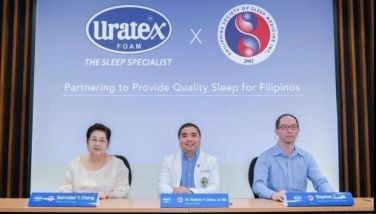Coping with tuberculosis
January 2, 2003 | 12:00am
Everyday, we hear of people suffering from dreaded sexually transmitted diseases such as HIV/AIDS or other fearsome illnesses like hepatitis and typhoid fever. One suffers not just from the physical burden of the disease but along with it comes a social stigma. Take the case of tuberculosis.
Tuberculosis carries a heavy stigma, such as rejection by neighbors, employers and co-workers. A lot of patients hesitate to disclose their TB status to family or friends out of fear of being socially ostracized. Since TB was incurable in the past, patients used to be isolated. Thus, TB became a social stigma.
Unfortunately, the stigma that surrounds TB comes from misconceptions about the disease, such as punishment for past wrongdoings, unhygienic habits or lifestyles. This can lead to rejection of the sufferers by their families and the community; they may also lose their jobs or receive little or no support during treatment.
The US Center for Disease Control and Prevention, for one, has reported that of a group of Vietnamese refugees studied in New York, 77 percent believed that the community would fear and avoid persons with TB.
The social stigma attached to TB occurs universally. Fear of stigma among Mexican immigrants in California caused TB patients to cease contact with their families and friends. Studies in India have shown that married women delay seeking treatment or hide their diagnosis from their husbands out of fear of being deserted. The list goes on.
Fortunately, with advances in medicine, tuberculosis now has a 95 percent cure rate. Patients have responded positively to treatment methods, particularly the Directly Observed Treatment Short Course (DOTS) strategy endorsed by the World Health Organization (WHO).
The personal attention of the DOTS strategy makes them feel cared for. The strategy also shows them that they can be cured of TB without going to a private doctor and hospitalization, thus leaving patients productive despite their predicament.
Under DOTS, a treatment partner observes a TB patient while taking his medicine daily throughout the six months of therapy. The scheme also educates and motivates the TB patient to comply with the treatment up to the final day.
For jeepney driver William Neburiano, a patient of the Philippine Tuberculosis Society Inc. in Tayuman, Manila, a treatment partner is important to make sure a patient takes his daily medication. After a few days of going to the health center for his medication, Mang Willie continued his treatment at home with the help and support of his wife.
It wasn’t easy at first. He had to take six different tablets and every time, he would feel dizzy. Later on, his wife found a way so Mang Willie would not have to swallow six pills all at the same time. She’d make him take three tablets, then the next three after a few minutes. That was their routine for the next six months until Mang Willie was declared TB-free.
His desire to recover faster sprang from the support his family showed him during his treatment period. His wife would dutifully give him his medication on the dot and would accompany him to his regular check-ups
GSK Foundation has started a program which it calls "DOTS Laban sa TB," a project in partnership with the Philippine Tuberculosis Society Inc. (PTSI). This anti-TB initiative follows the WHO-recommended Directly Observed Treatment Short Course (DOTS) with focus on the working age group, the most economically productive age group.
Under the program, GSK Foundation will provide free anti-TB treatment to patients while the PTSI will handle the implementation of the program that includes screening, diagnosis, treatment and monitoring and information dissemination. GSK will donate millions of pesos worth of medicines for some 1,300 patients annually.
A unique aspect of the program, "Family DOTS," involves the TB patients’ family members who will serve as their treatment partners to ensure that medicines are taken regularly and appropriately.
Tuberculosis carries a heavy stigma, such as rejection by neighbors, employers and co-workers. A lot of patients hesitate to disclose their TB status to family or friends out of fear of being socially ostracized. Since TB was incurable in the past, patients used to be isolated. Thus, TB became a social stigma.
Unfortunately, the stigma that surrounds TB comes from misconceptions about the disease, such as punishment for past wrongdoings, unhygienic habits or lifestyles. This can lead to rejection of the sufferers by their families and the community; they may also lose their jobs or receive little or no support during treatment.
The US Center for Disease Control and Prevention, for one, has reported that of a group of Vietnamese refugees studied in New York, 77 percent believed that the community would fear and avoid persons with TB.
The social stigma attached to TB occurs universally. Fear of stigma among Mexican immigrants in California caused TB patients to cease contact with their families and friends. Studies in India have shown that married women delay seeking treatment or hide their diagnosis from their husbands out of fear of being deserted. The list goes on.
Fortunately, with advances in medicine, tuberculosis now has a 95 percent cure rate. Patients have responded positively to treatment methods, particularly the Directly Observed Treatment Short Course (DOTS) strategy endorsed by the World Health Organization (WHO).
The personal attention of the DOTS strategy makes them feel cared for. The strategy also shows them that they can be cured of TB without going to a private doctor and hospitalization, thus leaving patients productive despite their predicament.
Under DOTS, a treatment partner observes a TB patient while taking his medicine daily throughout the six months of therapy. The scheme also educates and motivates the TB patient to comply with the treatment up to the final day.
For jeepney driver William Neburiano, a patient of the Philippine Tuberculosis Society Inc. in Tayuman, Manila, a treatment partner is important to make sure a patient takes his daily medication. After a few days of going to the health center for his medication, Mang Willie continued his treatment at home with the help and support of his wife.
It wasn’t easy at first. He had to take six different tablets and every time, he would feel dizzy. Later on, his wife found a way so Mang Willie would not have to swallow six pills all at the same time. She’d make him take three tablets, then the next three after a few minutes. That was their routine for the next six months until Mang Willie was declared TB-free.
His desire to recover faster sprang from the support his family showed him during his treatment period. His wife would dutifully give him his medication on the dot and would accompany him to his regular check-ups
GSK Foundation has started a program which it calls "DOTS Laban sa TB," a project in partnership with the Philippine Tuberculosis Society Inc. (PTSI). This anti-TB initiative follows the WHO-recommended Directly Observed Treatment Short Course (DOTS) with focus on the working age group, the most economically productive age group.
Under the program, GSK Foundation will provide free anti-TB treatment to patients while the PTSI will handle the implementation of the program that includes screening, diagnosis, treatment and monitoring and information dissemination. GSK will donate millions of pesos worth of medicines for some 1,300 patients annually.
A unique aspect of the program, "Family DOTS," involves the TB patients’ family members who will serve as their treatment partners to ensure that medicines are taken regularly and appropriately.
BrandSpace Articles
<
>
- Latest
Latest
Latest
October 25, 2024 - 9:00am
October 25, 2024 - 9:00am
October 24, 2024 - 11:20am
October 24, 2024 - 11:20am
October 14, 2024 - 11:00am
October 14, 2024 - 11:00am
October 11, 2024 - 12:49pm
October 11, 2024 - 12:49pm
September 30, 2024 - 8:00am
September 30, 2024 - 8:00am
September 26, 2024 - 2:00pm
September 26, 2024 - 2:00pm
Recommended






























